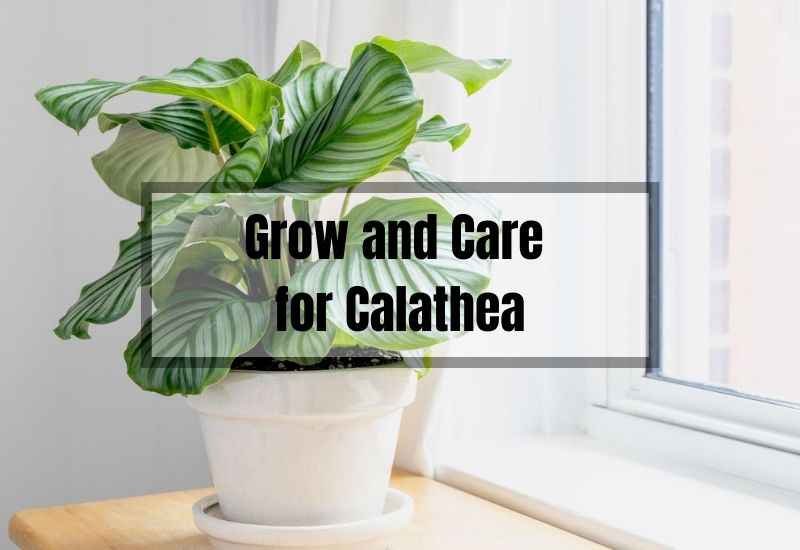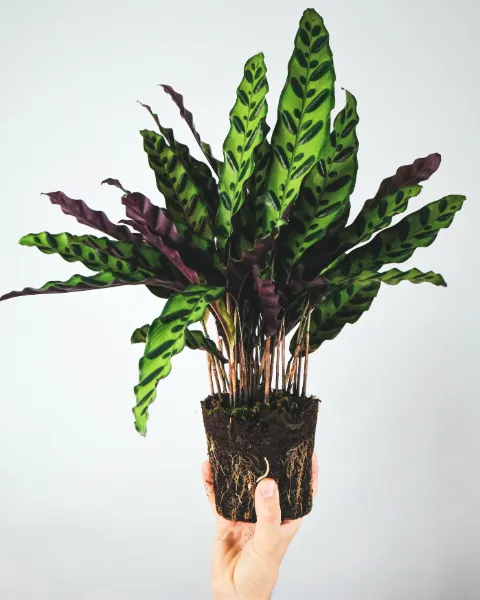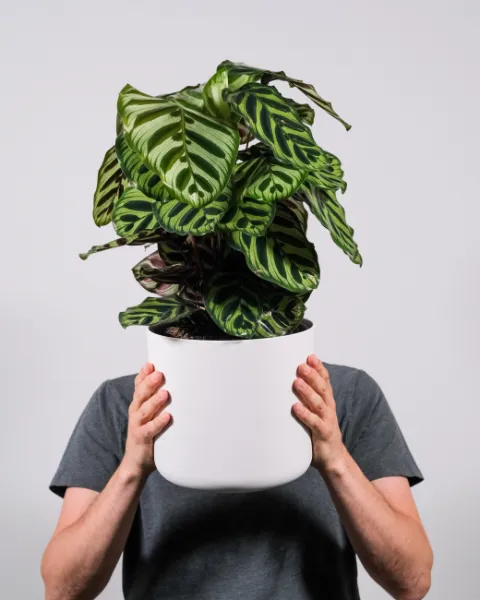How to Grow and Care for Calathea: A Professional Guide
If you’re looking to add some greenery to your home, Calathea plants may be just what you need. These plants are known for their stunning foliage with elegant patterns that are sure to captivate any pattern enthusiast or houseplant lover.
With a variety of shapes and stripes ranging from pink to white, Calathea plants are a true wonder of nature that will add a vibrant, lush green look to your indoor space.
In this article, you’ll learn about the features and characteristics of Calathea plants, how to grow and propagate them, potting and repotting tips, and common problems and solutions.
You’ll also discover the many uses of Calathea plants and how they can help create a tropical oasis in your own home. So, get ready to explore the beauty of Calathea plants and bring a touch of nature to your indoor space.
Key Takeaways
- Calathea plants have stunning foliage with elegant patterns that range from pink to white.
- You can learn how to grow and propagate Calathea plants, pot and repot them, and solve common problems.
- Calathea plants can help create a tropical oasis in your own home.

About Calathea
Calathea is a genus of plants that belongs to the Marantaceae family, which includes over 530 different species. This family was named after the native word ‘Maranta,’ which means edible arrowroots.
The Marantaceae family was once distributed across Gondwanaland, which was the largest landmass in the southern hemisphere made up of South America, Africa, Antarctica, and Australia.
Calatheas have close cousins in the Marantaceae family, such as Maranta, Ctenanthe, and Stromante. These plants are also known as ‘Prayer plants’ because they lift their leaves close to each other at night, similar to how we fold our hands while praying. The Calathea genus has over 300 species in total, making it a large family of plants.
Calatheas are rhizomatous, which means they have underground stems capable of giving rise to new roots and shoots from nodes. Some species have tuberous roots, such as Calathea allouia. These plants are friendly to us, dogs, and our feline companions.
Calatheas are popular houseplants due to their eye-catching stripes and veining, which give them nicknames such as the zebra plant, peacock plant, or rattlesnake plant.
They are native to jungle and tropical regions and grow at the base of trees. The large leaves help them survive in shady locations by performing photosynthesis. Calatheas are perennial and can survive all year round, making them great companions that keep us connected to nature.
Features and Characteristics of Calathea
Calatheas are known for their unique and stunning foliage. The leaves come in different shapes, ranging from long elliptical to ovate shapes.
Some have basal leaves that form beautiful rosettes, while others have leaves attached to colorful stems. The leaves are either smooth, shiny, or covered with fine hair that gives a soft velvety touch.
The most amazing part is that they have patterns on leaves. Some species get their names based on patterns such as rattlesnake or peacock plant. Additionally, their undersides in some species are dark purple to maroon hue, which is truly astounding.
Here are some of the most astonishing features and characteristics of some species:
Calathea Makoyana: The Peacock Plant
Calathea makoyana, also known as the peacock plant, has foliage that looks like the glorious peacock tail and grows up to 2ft long. Each leaf grows up to 10-12 inches and is pale green in color with a dark green imprint giving feather patterns. Its bold pattern extends from the middle to the outer edge.
Some leaves are rolled up, displaying deep purple undersides, which are new growth. When they mature, they unfurl and show off their elegant leaves. It blooms tiny white flowers but is not as attractive as its green foliage.
Calathea Vittata
Calathea vittata has dark green, large, elongate leaves with white paintbrush strokes. The stripes give amazing contrast that stretches from midrib to edges, making it a truly beautiful plant.
Calathea Network
Calathea network has foliage consisting of green scallop edge leaves with a mosaic pattern in yellow. So it is also known as Calathea Musaica. It grows up to 60cm long and looks fascinating.
Calathea Majestica
Calathea majestica has oblong dark green leaves with white to pink magical stripes. Additionally, the deep purple underside adds another burst and spark of colors, making it a true white star in the form of a plant.
Calathea Zebrina
Calathea zebrina has magnificent foliage with smooth, soft, velvety, oval light green leaves. Above those leaves lies the dark green zebra-like stripes that stretch from midrib to edges.
The undersides are dark purple. These leaves can be 15 inches or more in length and sit at the top of a long stalk up to 1 m tall. It blooms purple or white modest flowers in late summer, early fall. It does not bloom indoors, but this plant still amazes us with its beautiful, enormous spread of foliage.
Calathea Lancifolia
Calathea lancifolia is generally known as the rattlesnake plant because of the markings found on the leaves. Its amazing-looking pale green leaves with variegate patterns never fail to amaze.
The patterns are dark green elliptic blotches arranged on both sides of the midrib. Its wavy lanceolate margin edges are decorated with olive green color. Its undersides are also colored, having reddish-purple to maroon.
Calathea Orbifolia
Calathea orbifolia harbors round, luxurious, lush green leaves with cunning pale silver-green stripes, giving it an absolute dramatic look. The foliage is gorgeous to look at.
Calathea Picturata
Calathea picturata bears pale, silvery-green, ovate leaves with edges decorated with dark green. The undersides are dark purple. The Royal Horticultural Society appreciates Calathea picturate ‘Argentea’ with an award.
Calathea Roseopicta
Calathea roseopicta has many cultivars, all of which have feathered borders of different colors and grow up to 50cm. Calathea roseopicta ‘Dottie’ is the species of Calathea that contrasts our green foliage.
It has deep purple color leaves, feather-like imprints made up of pink variegation around the leaf edge, and a stunning pink midrib. Calathea roseopicta ‘Medallion’ has pale green leaves and dark green feather-like patterns.
Calathea ‘White Fusion’
Calathea ‘White Fusion’ has lanceolate green leaves with white paintbrush stroke patterns, giving it a frosty look. It has a deep purple underside.
Calathea Rufibarba: ‘Velvet Calathea’ or ‘Furry Feather Calathea’
Calathea rufibarba, also known as the velvet calathea or furry feather calathea, has velvety, feather-like, slender, wavy-edged leaves.
It has beautiful purple undersides, and their stalks are also purple in color. It grows up to 3 feet tall,
How to Grow Calathea

If you want to grow Calathea, you need to provide it with the right growing conditions. Although there are different types of Calathea, the care factor is the same as they are all tropical plants. Here are some tips on how to grow Calathea.
Potting Mix
Calathea requires a well-draining potting mix to avoid water sopping around. You can use general-purpose houseplant potting mix that provides good drainage.
For best results, use a potting mix of peat moss, coconut coir, pine bark, and either perlite or vermiculite. You can also prepare your own mix by adding 2 parts peat and 1 part sand or perlite. Maintain the pH of the potting mix to 6.5.
Watering
Calathea loves moist soil but not soggy soil. You can check the soil by touching your finger into it. If it is about to dry, water it until it slips out of the drainage holes. Let the excess water flow out, and then your soil is moist.
In winter, Calathea grows slowly, so don’t overwater it. It needs water when the soil is dry up to 2 inches down. If the leaves turn yellow, that means you are adding excess water.
If they turn brown, it means they need more water. Calathea hates fluoride and chlorine in the water, so it’s better to use rainwater or distilled water.
Light
Calathea loves to sit in an area of your sweet home where the bright indirect sunlight touches it.
East or north-facing windows are the best. Direct sunlight gives brown edges and bleaches its leaves.
Temperature
Calathea is comfortable in temperatures between 60-75°F. If you live in cold regions, don’t let the plant freeze outside. Keep it in a space where the temperature stays at least above 55°F.
Humidity
Calathea loves humidity around it. Humidity more than 60% is the best for keeping the plant healthy and happy. If you want to maintain humidity, you can place the plant on a tray with pebbles damp with water.
Don’t let the water enter the pot, or else it will start to rot the roots. Misting is another option. Investing in a humidifier will be best.
The easy way is to place the plant with other houseplants. The humidity spreads due to transpiration of surrounding plants.
Container
Use a wide container with enough drainage holes to grow Calathea.
Fertilizer
Dilute the water-soluble fertilizer at half strength. During the growing season till early Autumn, apply every 2-4 weeks. NPK 3-2-1 is best. In winter, the growth is slow, so there is no need to add fertilizer.
Pruning
Calathea doesn’t need much pruning. Prune old leaves that are yellow or brown with sterile scissors to give it a nice compact and bushy look.
Propagating Calathea
Propagation via Division method
To propagate Calathea in spring and summer, you can use the division method. Take two different containers and fill them with potting mix. Then, use a sterile sharp knife to divide the mature crown into halves and plant them in the two different containers.
Cover the containers with a plastic bag to maintain warmth and moisture until new growth appears. Provide appropriate growth conditions and watch for the beautiful, elegant leaves to unfold as the plant matures.
Propagating using tissue culture method: Perform in lab.
For large scale production of Calatheas, you can perform micro-propagation in a lab. This method encourages fast formation of roots and plantlets.
Transfer the plantlets to your soil mix and provide appropriate conditions to encourage growth. Wear your lab-coats and provide a tropical feel for your plants to flourish.
Potting and Repotting
To ensure healthy growth, it is recommended to repot your Calathea every 2-3 years during the growing season, which is in spring or early summer. When repotting, use a container with enough drainage holes and fresh potting mix.
Avoid adding a drainage layer, as it can be more detrimental than useful. If the plant is root-bound, loosen the roots a little before placing it in its new home.
Add some potting mix around it and provide appropriate growing conditions. Your Calathea should bounce back from repotting shock.
Common Problems and Solutions

Issue: Brown and mushy root rot and leaves turn yellow, wilt, or droop.
Overwatering your plant can lead to root rot, which promotes the growth of Pythium, Phytophthora, Rhizoctonia, or Fusarium fungi. Repot or propagate the healthy section of your plant to solve this issue.
To avoid this issue in the future, make sure to water your plant when the soil is dry to the touch and avoid letting it sit in standing water.
Issue: Reddish brown spots on the leaves.
Pseudomonas leaf spot is the most common disease that affects our plant. Remove all leaves that have reddish brown spots and apply a copper-based bactericide to the remaining leaves. This will help prevent the disease from spreading.
Issue: Spider-like web at the base of the plant and between leaves, discoloration or yellow leaves.
Spider mites are a common pest that can attack your plant. To get rid of them, use a mild soapy water or herbal spray. For the herbal spray, crush peppermint and rosemary and add them to 3 cups of water.
Leave the mixture for a day and then separate out the herbs. Add 1/4 teaspoon of mild dish soap and spray it on your plant. For the soapy water, fill a quarter of a spray bottle with water and add 1 tablespoon of dish soap. Spray it on a leaf and if it curls, dilute it further by adding more water.
You can also use a cooking oil pest spray. Mix 1 tablespoon of mild dish soap with 1 cup of cooking oil to make the spray. Whenever you need it, take two cups of water in the spray bottle and add 4 teaspoons of mild dish soap. Spray it on your plant and wait until it dries out before applying it again.
Issue: Foliage distorted and leaf drop.
Aphids are pear-shaped insects that eat sap from your plant and secrete honeydew. To treat this issue, clean your leaves with a soft cloth and use a herbal spray, soapy water, or cooking oil pest spray as mentioned above.
Issue: Leaf curls and spots appear on it.
Under-watering your plant can cause leaf curls and spots to appear. Make sure to water your plant when the soil is dry to the touch. You can use a moisture meter to check the soil moisture level.
Issue: Leaf margins show chlorotic and necrotic lesions.
Fluoride toxicity can cause leaf margins to show chlorotic and necrotic lesions. Increase the pH of the potting mix to 6.5 or 7 by adding dolomite or calcium hydroxide to solve this issue.
Issue: Reduction in foliage color and leaf spotting.
If the fertilizer you are providing is rich in potassium, it can cause a reduction in foliage color and leaf spotting. Provide a 3:1:2 ratio of NPK fertilizer to solve this issue.
Related Posts:
- Overwatering Houseplants: How to Avoid Killing Your Plants
- Root Rot in Plants: Causes, Symptoms, and Treatment
Uses of Calathea
Calatheas are not only beautiful and ornamental indoor plants but also have several practical uses. Here are some of the uses of Calatheas:
- Air purification: Calatheas are great air purifiers as they have pores on their leaves that trap carbon dioxide and release oxygen into the air. Additionally, their waxy leaves trap dust particles, making them excellent dust trappers.
- Humidity addition: Calatheas thrive in humid environments, making them perfect for adding humidity to dry air. This can help reduce dry skin conditions and respiratory problems.
- Relaxation and focus: The fractal pattern on Calatheas triggers an alpha response, which induces a relaxed but wakeful state of mind. This can help ease the effects of blue screen technology and promote relaxation and focus.
- Ethno-botanical use: Some species of Calatheas hold ethno-botanical importance. For example, Calathea allouia is a tuberous crop rich in protein and starch that is enjoyed as a seasonal snack or festival food in the Caribbean and South America. The flowering spikes of this species are also edible.
- Practical use: Calathea lutea has waxy, large leaves that make it ideal for making waterproof baskets.
- Cultural uses: In Brazil, Calatheas leaves are used to wrap fish for transport, while in Thailand, Calatheas leaf rice containers are famous in local markets.
Calatheas are versatile plants that offer both aesthetic and practical benefits. Consider incorporating them into your home or office space.
Conclusion
In conclusion, Calatheas are an excellent choice for indoor houseplants due to their stunning patterned leaves. They add a touch of tropical beauty to any space, whether it be at home or in the office.
Additionally, Calatheas are known for their air-purifying properties and ability to promote relaxation and focus. With this complete guide, you now have the knowledge to grow beautiful Calatheas and enjoy their benefits.





